The ASUS X99 Rampage V Extreme ROG Review
by Ian Cutress on June 22, 2015 8:45 AM EST- Posted in
- Motherboards
- Asus
- ROG
- Haswell-E
- X99
Gaming Performance 2015
As we have not tested our mid-2015 suite on many products yet, we have relatively few results and these are included here for completeness. I've included a few CPU based results as well, to see perspective.
Alien: Isolation
If first person survival mixed with horror is your sort of thing, then Alien: Isolation, based off of the Alien franchise, should be an interesting title. Developed by The Creative Assembly and released in October 2014, Alien: Isolation has won numerous awards from Game Of The Year to several top 10s/25s and Best Horror titles, ratcheting up over a million sales by February 2015. Alien: Isolation uses a custom built engine which includes dynamic sound effects and should be fully multi-core enabled.
For low end graphics, we test at 720p with Ultra settings, whereas for mid and high range graphics we bump this up to 1080p, taking the average frame rate as our marker with a scripted version of the built-in benchmark.
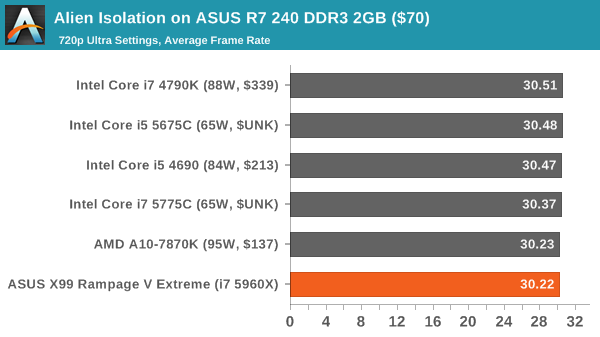
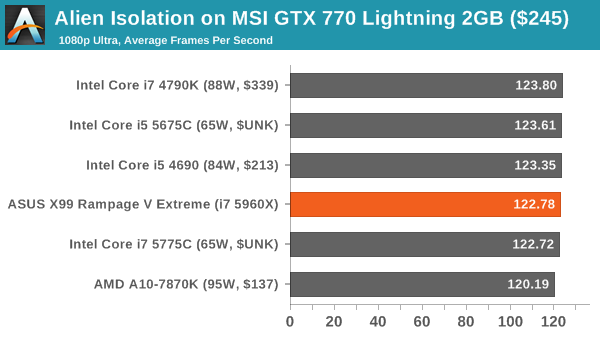
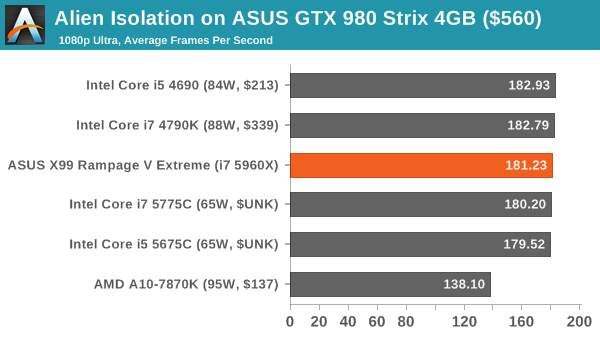
Total War: Attila
The Total War franchise moves on to Attila, another The Creative Assembly development, and is a stand-alone strategy title set in 395AD where the main story line lets the gamer take control of the leader of the Huns in order to conquer parts of the world. Graphically the game can render hundreds/thousands of units on screen at once, all with their individual actions and can put some of the big cards to task.
For low end graphics, we test at 720p with performance settings, recording the average frame rate. With mid and high range graphics, we test at 1080p with the quality setting. In both circumstances, unlimited video memory is enabled and the in-game scripted benchmark is used.
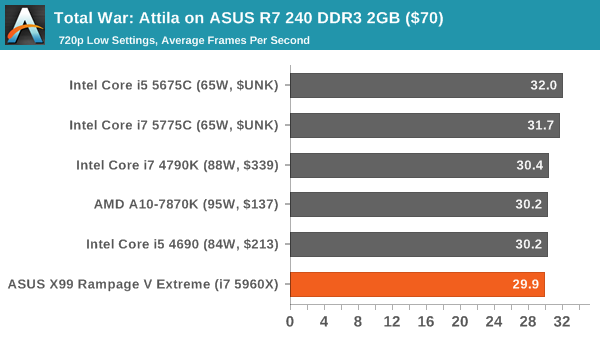
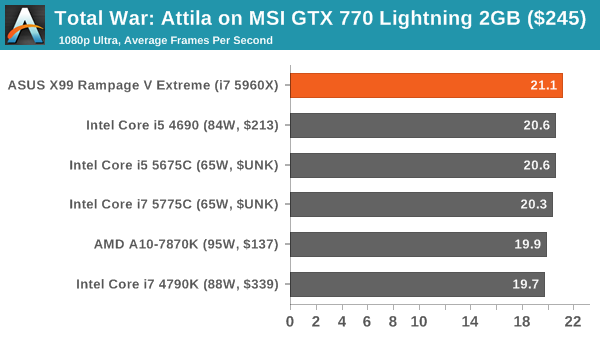

GRID: Autosport
No graphics tests are complete without some input from Codemasters and the EGO engine, which means for this round of testing we point towards GRID: Autosport, the next iteration in the GRID and racing genre. As with our previous racing testing, each update to the engine aims to add in effects, reflections, detail and realism, with Codemasters making ‘authenticity’ a main focal point for this version.
GRID’s benchmark mode is very flexible, and as a result we created a test race using a shortened version of the Red Bull Ring with twelve cars doing two laps. The car is focus starts last and is quite fast, but usually finishes second or third. For low end graphics we test at 1080p medium settings, whereas mid and high end graphics get the full 1080p maximum. Both the average and minimum frame rates are recorded.
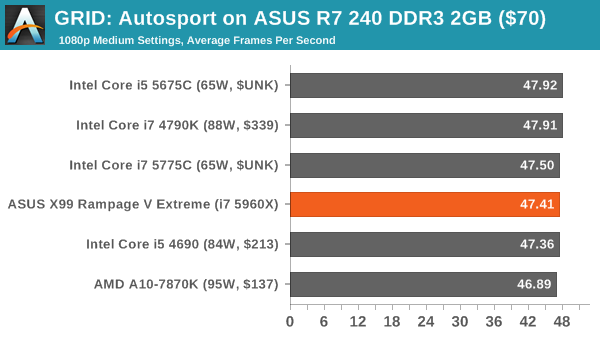
![GRID: Autosport on ASUS R7 240 DDR3 2GB ($70) [Minimum FPS]](https://images.anandtech.com/graphs/graph9278/75186.png)
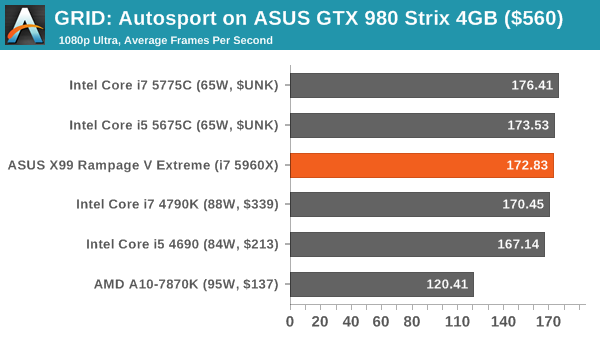
![GRID: Autosport on ASUS GTX 980 Strix 4GB ($560) [Minimum FPS]](https://images.anandtech.com/graphs/graph9278/75204.png)
Middle-Earth: Shadows of Mordor
The final title in our testing is another battle of system performance with the open world action-adventure title, Shadows of Mordor. Produced by Monolith using the LithTech Jupiter EX engine and numerous detail add-ons, SoM goes for detail and complexity to a large extent, despite having to be cut down from the original plans. The main story itself was written by the same writer as Red Dead Redemption, and it received Zero Punctuation’s Game of The Year in 2014.
For testing purposes, SoM gives a dynamic screen resolution setting, allowing us to render at high resolutions that are then scaled down to the monitor. As a result, we get several tests using the in-game benchmark. For low end graphics we examine at 720p with low settings, whereas mid and high end graphics get 1080p Ultra. The top graphics test is also redone at 3840x2160, also with Ultra settings, and we also test two cards at 4K where possible.
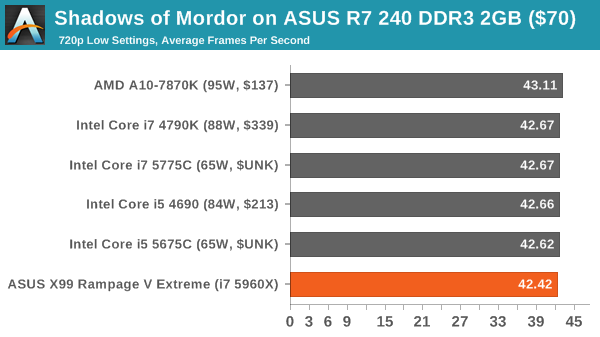
![Shadows of Mordor on ASUS R7 240 DDR3 2GB ($70) [Minimum FPS]](https://images.anandtech.com/graphs/graph9278/75188.png)
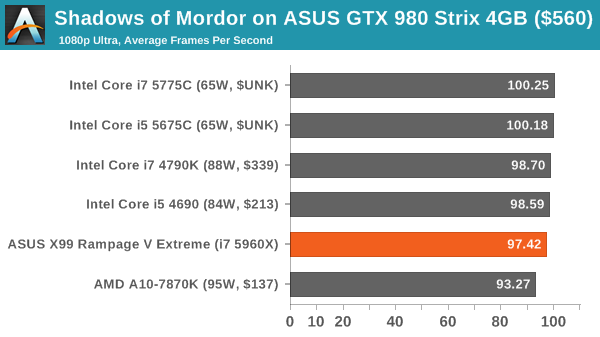
![Shadows of Mordor on ASUS GTX 980 Strix 4GB ($560) [Minimum FPS]](https://images.anandtech.com/graphs/graph9278/75208.png)














41 Comments
View All Comments
dark4181 - Monday, June 22, 2015 - link
No mention of NVMe support? EATX? Dealbreakers for me. I need ATX formfactor and NVMe support. Looks like I'm getting the X99-Pro/3.1freeskier93 - Monday, June 22, 2015 - link
Asus has already said all Z97 and X99 will have NVMe support, not sure why this would be an exception.SirGCal - Monday, June 22, 2015 - link
Surprised they don't have USB C in there also. Everything else but missing out on the super fast and flexible new USB support. I'll wait some more. And ya, no EATX For me either anymore...BPB - Monday, June 22, 2015 - link
The article states there is a version with USB 3.1DanNeely - Monday, June 22, 2015 - link
It's USB3.1 but still A style connectors, not the new C one. The addin board providing it is PCIe x4; so you're giving up a 4way GPU setup to use it. A minor concern for most people, but it goes toward the existing you can have it all but not all at once problem the board has.BPB - Monday, June 22, 2015 - link
Good points. I don't see a need for the new connector for a while, but I think Asus should have included it.Breit - Tuesday, June 23, 2015 - link
You know this board was released back in august 2014, right?movieman03 - Monday, June 22, 2015 - link
I think they had to go EATX to fit all the PCI-e slots and a full size M.2. There is just a lot going on. I have the Z97 Maximus VII forumula and ASUS gave us a little riser card that limits the physical size of the M.2, so it is nice to see them able to use the full size with this oneDanNeely - Monday, June 22, 2015 - link
"As with any purchase of a high end motherboard for gaming, taking it out of the box is an experience. Only a system builder that has to put together 50 systems a week would get bored of it."Seriously. I think the only time I was even vaguely excited about all the stuff bundled in with a board was 14 years ago when I built my first box. The last time I cared about a major chunk of the bundled stuff was 8 or 9 years ago when I build my first sata box and needed new cables. Now...
Looking at the bundle on Newegg my reactions are: Are those cables with LEDs on the end?!?! Even if I had a case with a Window and wanted to bling my system out in the tackiest gamer style *gag*, those probably wouldn't be the right colors for what I wanted. I've got probably 10 sata cables for every sata drive I own at this point; that's the last thing I need now. Ditto for the collection of SLI bridges. I'll be OCing this box once when I first build it, after that point that OC handset thingy will be totally worthless; and even then sitting on the table is fine I don't need a stand for it. On the plus side, no USB/firewire bracket. On the minus side, it looks like they're missing the one useful bit of the bundle: the little header blocks that let you bundle all the front panel connectors into a single block where you can see what you're doing before plugging them in. (The fact that virtually everyone is using a decade+ old standard for how the headers are laid out; but no case vendor is willing to put them into a unified block continues to enrage me every time I build a new system.)
Schickenipple - Monday, June 22, 2015 - link
I'll second that comment about the switch/LED header blocks. I can't believe it's not a standard by now!